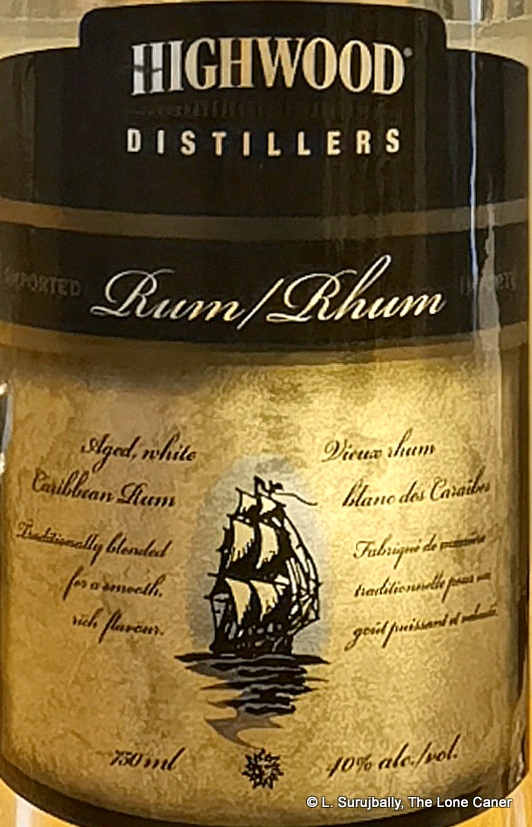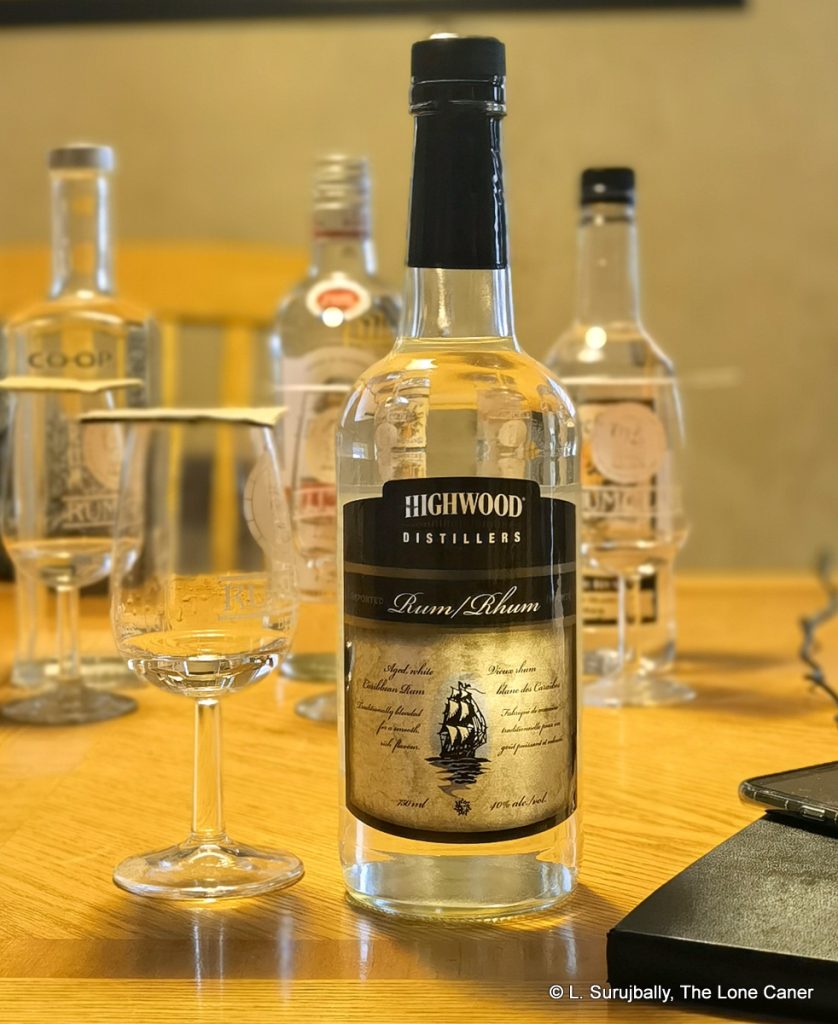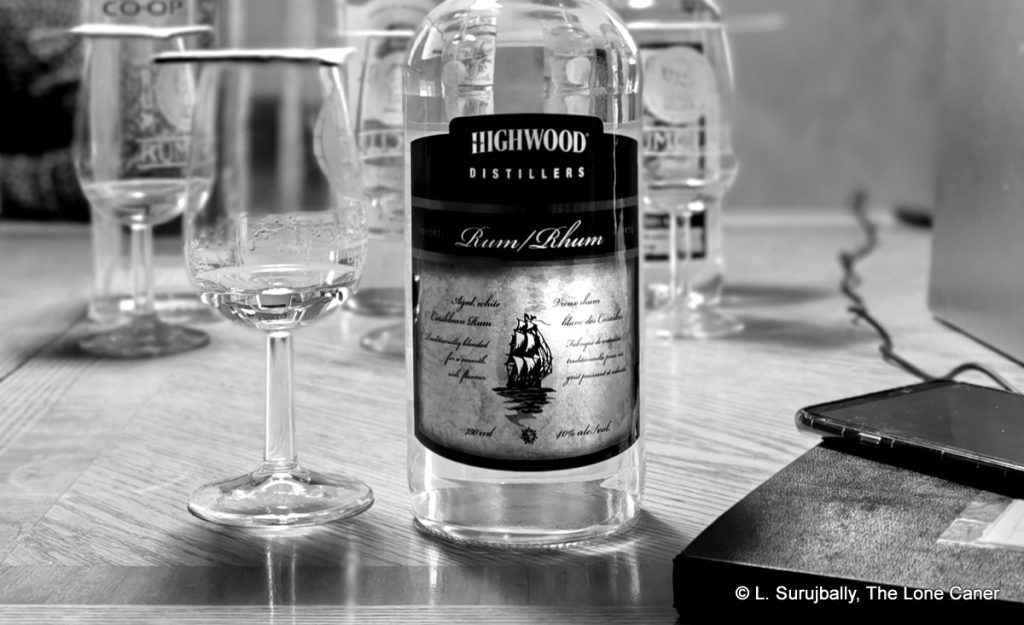This is not the first review to be speaking to a rum made or released by the western Canadian outfit Highwood Distillers: I’ve looked at the forgettable Momento, the guilty pleasure of Potters Dark, and a completely indifferent contract throwaway called Merchant Shipping Co. white rum (made for Wine & Beyond, a large local spirits shop chain), which some readers might recall I disliked intensely when I tried it earlier this year. At that same session I sampled their own simply labelled 40% white, and was a little more impressed than with the others…but I’m afraid that’s nothing to make you rush to the nearest store to go buy some.
 The rum is a product that channels something of no-great-shakes median-scoring Plantation Three Star — without the character. It’s made from near neutral alcohol from Guyana that’s imported at 95% and aged for a year in ex-bourbon casks before being filtered to white and taken down to 40% (it remains an outstanding query with them as to where the ageing takes place). These facts, then, position it squarely in the cheap mixers’ blends section of the market that has no aspirations to be seen as an artisanal classic, so tempering expectations commensurately is a must.
The rum is a product that channels something of no-great-shakes median-scoring Plantation Three Star — without the character. It’s made from near neutral alcohol from Guyana that’s imported at 95% and aged for a year in ex-bourbon casks before being filtered to white and taken down to 40% (it remains an outstanding query with them as to where the ageing takes place). These facts, then, position it squarely in the cheap mixers’ blends section of the market that has no aspirations to be seen as an artisanal classic, so tempering expectations commensurately is a must.
Back in 2009 when my fellow rum chum The Rum Howler first looked at this product, he commented that he was able to discern its Guyanese nature: I assure you that no such profile attends to the one I tried 14 year later. It is redolent of rubbing alcohol infused with coconut shavings, with some subtle threads of sugar water, overripe white fruit, crackers, salt biscuits …and the musty, dusty scent of abandoned houses. There’s no wooden still action, no dark fruits, or tannins or raisins or licorice or sawdust. It’s really quite easy to smell, smoothly light and inoffensive…and here that means it’s simply bland.
On the palate it retains a neutral character: tangy, lightly sweet, alcoholic. It tastes, at best, of a few indistinguishable sodden watery fruit in a graceless salad sprinkled with some alcohol and icing sugar. One can sense some pears, swank, a fine line of brine and light citrus (this is being generous), perhaps a touch of melon and coconut shavings, all of which serves to make it better than alcoholic water, but not by a whole lot. The finish is smooth, light and relatively clean, just ultimately without much of anything.
Which, as has been mentioned to me before, is probably the point: for something made to be a cocktail ingredient, I should not ask for more. Maybe so. Expectations were low going in and the rum met them swimmingly. It is still being made almost two decades after being introduced, so it has to have something to recommend it. The problem for me is, that “something” is only price for purpose. It’s relatively cheap, it gets people buzzed and its blandness make it well suited for cocktails where it’s the other ingredients that shine, not the base rum.
Yet I take umbrage at the casual throwaway nature of the white, because I feel that if we are ever to grow the rum category in western Canada, local distillers have to stop with this “it’s cheap” one-size-fits-all mentality that is solely meant as a vehicle to move cases. Surely it’s possible to do more than just make a forgettable, affordable rum? How about an unforgettable one?
 And I say that because I’ve seen what small rum companies in other countries do with lesser facilities and just some gumption and the desire to try making something interesting, something better. They’re making Jamaican wannabes in the UK and Down Under, using wooden pot stills in Japan, dicking around with Swedish oak in Denmark, to name just a few wild and woolly ideas that make rum more interesting: those guys experiment, they go off the reservation, they do it all themselves, and they make rums that sing in cocktails and enthuse aficionados the world over, and yes, they sell too.
And I say that because I’ve seen what small rum companies in other countries do with lesser facilities and just some gumption and the desire to try making something interesting, something better. They’re making Jamaican wannabes in the UK and Down Under, using wooden pot stills in Japan, dicking around with Swedish oak in Denmark, to name just a few wild and woolly ideas that make rum more interesting: those guys experiment, they go off the reservation, they do it all themselves, and they make rums that sing in cocktails and enthuse aficionados the world over, and yes, they sell too.
In contrast, what do we get here? A Caribbean rum of zero taste and originality that doesn’t even channel its point of origin or advertise its source. It smells anonymous. It does nothing. It tells you nothing. It could be anything, come from anywhere, and be for anyone. Tell me, in what universe does that count as a successful product?
(#1030)(72/100) ⭐⭐½
Company background
The company is a distillery founded in 1974, originally called ‘Sunnyvale’. In 1984, it was renamed Highwood Distillers after the river that flows through the town of High River in which the distillery is located (in Alberta, just south of Calgary). Until 1997, both the distillery and sales offices were located at the distillery but then the sales office moved to town (which is to say, Calgary), while the distillery continues where it started, and where it remains to this day. In 2005 they bought the BC-based Potter’s distillery, as well as the brands they owned which is why Potter’s Light and Dark rums are part of Highwood’s current portfolio.
The acquisition of Potters and the expansion into general spirits – vodka, rum, whiskey, gin, liqueurs, flavoured spirits – marked the limit of how far Highwood seemed to want to go, and no further purchases, acquisitions or portfolio increases attended the company for the next decade and a half. Interestingly, in 2022 the Nova Scotia based whisky distiller Caldera Distilling, bought out Highwood in a push to expand into western Canada, thereby creating what is touted as the largest family owned distillery in Canada; however so far it does not seem as if much has changed and if the two company websites are anything to go by, with neither company referring to the other, then it suggests a rather hands-off and independent approach to production.
